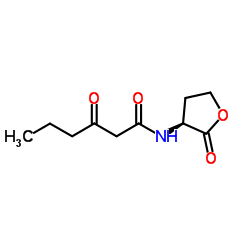N-(3-氧代己酰)-DL-高丝氨酸内酯

N-(3-氧代己酰)-DL-高丝氨酸内酯结构式

|
常用名 | N-(3-氧代己酰)-DL-高丝氨酸内酯 | 英文名 | N-(Ketocaproyl)-D,L-homoserine lactone |
|---|---|---|---|---|
| CAS号 | 76924-95-3 | 分子量 | 213.230 | |
| 密度 | 1.2±0.1 g/cm3 | 沸点 | 482.9±45.0 °C at 760 mmHg | |
| 分子式 | C10H15NO4 | 熔点 | N/A | |
| MSDS | 美版 | 闪点 | 245.9±28.7 °C |
|
Substrate specificity and function of the pheromone receptor AinR in Vibrio fischeri ES114.
J. Bacteriol. 195(22) , 5223-32, (2013) Two distinct but interrelated pheromone-signaling systems, LuxI/LuxR and AinS/AinR, positively control bioluminescence in Vibrio fischeri. Although each system generates an acyl-homoserine lactone (AHL) signal, the protein sequences of LuxI/LuxR and AinS/AinR... |
|
|
Attenuation of Vibrio fischeri quorum sensing using rationally designed polymers.
Biomacromolecules 11(4) , 975-80, (2010) A first attempt to attenuate the quorum sensing (QS) of a marine heterotroph microorganism, Vibrio fischeri , using signal molecule-sequestering polymers (SSPs) is presented. A set of rationally designed polymers with affinity toward a signal molecule of V. f... |
|
|
The crystal structure of the Escherichia coli autoinducer-2 processing protein LsrF.
PLoS ONE 4(8) , e6820, (2009) Many bacteria produce and respond to the quorum sensing signal autoinducer-2 (AI-2). Escherichia coli and Salmonella typhimurium are among the species with the lsr operon, an operon containing AI-2 transport and processing genes that are up regulated in respo... |
|
|
Identification of hydroxyl radical oxidation products of N-hexanoyl-homoserine lactone by reversed-phase high-performance liquid chromatography coupled with electrospray ionization tandem mass spectrometry.
Rapid Commun. Mass Spectrom. 23(8) , 1212-20, (2009) A reversed-phase high-performance liquid chromatography/electrospray tandem mass spectrometry method was developed for the characterization of hydroxyl radical oxidation products of N-hexanoyl-homoserine lactone (C6-HSL), a member of the N-acylhomoserine lact... |
|
|
Establishing a quantitative definition of quorum sensing provides insight into the information content of the autoinducer signals in Vibrio harveyi and Escherichia coli.
Biochemistry 49(27) , 5621-3, (2010) Extracellular autoinducer concentrations in cultures of Vibrio harveyi and Escherichia coli were monitored by liquid chromatography-tandem mass spectrometry to test whether a quantitative definition of quorum sensing could help decipher the information conten... |
|
|
Two G-protein-coupled-receptor candidates, Cand2 and Cand7, are involved in Arabidopsis root growth mediated by the bacterial quorum-sensing signals N-acyl-homoserine lactones.
Biochem. Biophys. Res. Commun. 417(3) , 991-5, (2012) Many Gram-negative bacteria use N-acyl-homoserine lactones (AHLs) as quorum sensing (QS) signaling molecules to coordinate their group behavior. Recently, it was shown that plants can perceive and respond to these bacterial AHLs. However, little is known abou... |
|
|
Response of leaf-associated bacterial communities to primary acyl-homoserine lactone in the tobacco phyllosphere.
Res. Microbiol. 163(2) , 119-24, (2012) The phyllosphere is inhabited by large populations of epiphytic bacteria that are able to modulate their phenotypes and behavior by quorum sensing (QS). However, the impact of acyl-homoserine lactones (AHLs) involved in QS on the ecology of bacteria in their ... |
|
|
The chaperone GroESL enhances the accumulation of soluble, active TraR protein, a quorum-sensing transcription factor from Agrobacterium tumefaciens.
J. Bacteriol. 191(11) , 3706-11, (2009) TraR of Agrobacterium tumefaciens is a LuxR-type quorum-sensing transcription factor that regulates genes required for replication and conjugation of the tumor-inducing (Ti) plasmid. TraR requires its cognate autoinducer N-3-oxooctanoyl-homoserine lactone (OO... |
|
|
Microbial linguistics: perspectives and applications of microbial cell-to-cell communication.
BMB Rep. 44(1) , 1-10, (2011) Inter-cellular communication via diffusible small molecules is a defining character not only of multicellular forms of life but also of single-celled organisms. A large number of bacterial genes are regulated by the change of chemical milieu mediated by the l... |
|
|
A sensitive fluorescence reporter for monitoring quorum sensing regulated protease production in Vibrio harveyi.
J. Microbiol. Methods 84(2) , 189-93, (2011) Many bacteria produce and secrete proteases during host invasion and pathogenesis. Vibrio harveyi, an opportunistic pathogen of shrimp, is known to use a two-component quorum sensing (QS) mechanism for coordination of gene expression including protease secret... |